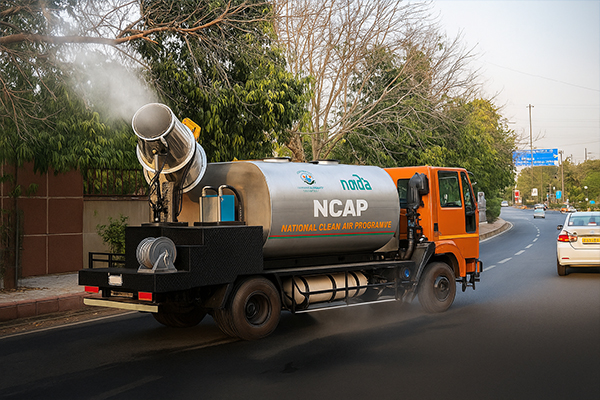How Do Anti-Smog Guns Operate and Are They Effective?

The familiar haze of smog returns to the skies as winter pollution tightens its hold on northern India. The Delhi government is increasing the use of Anti-Smog Guns (ASGs), which are devices that spray pollutants into the air, in an attempt to combat the steadily declining quality of the air. But can they actually have an impact, and how do they operate exactly?
The air has a heaviness to it along with a crispness. The city is plagued by a poisonous mixture of dust, industrial smoke, and vehicle emissions. In order to address the escalating crisis, authorities are placing additional ASGs in strategic locations as pollution levels are predicted to rise significantly over the coming weeks.
An Anti-Smog Gun: What Is It? How Does It Operate?
A device designed to spray extremely fine water droplets into the atmosphere is called an anti smog gun. These droplets, which have a size range of 50 to 100 microns, cling to airborne contaminants such as PM2.5 and PM10 and pull them to the ground. Imagine it as a synthetic rain that is intended to momentarily purify the air.
Usually mounted on a truck or stationary platform, the system is driven by high-pressure propellers and connected to a water tank. These guns create a canopy effect in the air by releasing a thick mist. With a spray volume of about 30 to 100 liters per minute, the spray can reach up to 150 feet in the air.
The anti-smog gun is also frequently referred to as a fog gun, spray gun, or mist cannon. After a trial run in Delhi in 2017, the idea has since spread to other cities and industries.
Where Do They Get Used?
The use of anti-smog firearms is not restricted to cities. In actuality, they are extensively utilized in sectors like:
1. Exploiting
2. Building
3. Plants that handle coal
4. Units for crushing stones
5. Sites of demolition
ASGs were used to manage the enormous dust clouds created during the demolition of the Noida twin towers, which is a noteworthy example of their application.
ASGs are equipped with various nozzle and propeller configurations based on the deployment area. While urban units use finer mists that can more effectively target suspended particles in the air, industrial areas usually require coarser nozzles for heavier dust particles.
Are Anti-Smog Guns Effective?
This is where the debate begins.
On the one hand, civic organizations contend that ASGs can rapidly lower airborne dust in areas with heavy traffic, building sites, or particular hotspots like Anand Vihar or ITO. They can, if only temporarily, reduce localized pollution levels when properly used.
However, scientists and environmental experts are still dubious. They contend that ASGs are merely a band-aid solution. Once the spray stops, their short-lived, localized effect fades. The mist spreads swiftly and has little time to cling to pollutants in large, open spaces like Delhi.
Additionally, he pointed out that unconfined ambient air, particularly in less dusty regions, does not give the mist enough time to bind to ultra-fine particles.
Additionally, each anti smog gun uses 40 to 250 liters of purified water per minute, which raises concerns about water waste, particularly in a nation where conserving water is becoming more and more important. Some experts wonder if the small and transient benefit outweighs the environmental cost.
Is It Optics or a Positive Step?
Somewhere in the middle is where the truth is.
Unquestionably, anti-smog guns are helpful in reducing visible dust, particularly in areas that are busy with industry and construction. Their ability to lower PM levels is genuine, albeit restricted. They are not a panacea for Delhi's complicated air quality issues, which are caused by poor waste management, industrial pollution, crop burning, and vehicle emissions.
These weapons can offer immediate respite at strategic points or during extreme AQI spikes, but their long-term effects will be negligible unless systemic changes are made to fuel consumption, urban planning, and transportation.
According to a representative of a civic body:
"We can stop dust from spreading into the air by placing anti-smog guns at specific locations."
Yes, but only to that extent. Anti-smog firearms are not a long-term solution for improving air quality; they are a temporary mitigation measure
In conclusion
The visible battle against toxic air will include anti-smog guns as Delhi prepares for another polluted winter. They will create news, they will lessen dust, and they will give us a little breathing room, but only for a short time.
India must look past the mist and concentrate on long-term, preventive measures if it wants cleaner air that lasts.

